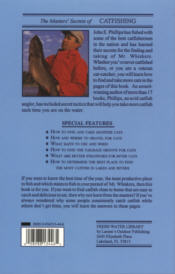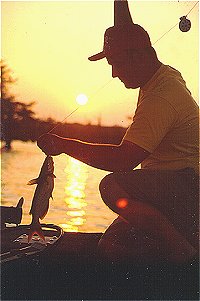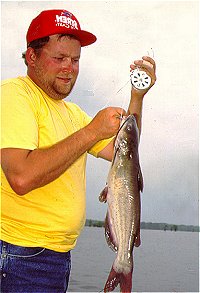
|
Features
|
|
|
|
Book Selections
|
|
Fun & Games
|
|
Contact Us
|
| Click on Images to Enlarge |
 |
CHAPTER 4
PLACES TO FIND CATFISH
One of the reasons many fishing-tackle manufacturers are eying the catfish as the next glamour species is because this fish is found in most waterways throughout the country. Catfish can be caught close to your home in little streams or as far away as Canada.
When farm ponds and stock tanks are built across the nation, catfish usually are one of the first species added. Besides providing recreation and food for the landowners' family, catfish also can produce a commercial crop for these landowners.
Catfish are probably the most accessible fish to the most anglers anywhere in the United States. Catfish require no expensive tackle. The bait to catch them often is inexpensive and easy to find. Here's a look at where you can locate catfish.
LARGE MAN-MADE LAKES
Thermocline
"Catfish aren't difficult to catch if you can pinpoint where they're roaming," Carl Lowrance of Lowrance Electronics said. "I've been locating them for several decades, ever since I invented the inland depthfinder."
Mr. Lowrance explains that he does not start looking for catfish with his depthfinder until the thermocline is well- established, usually in the summer.
"During May in my area of the Midwest, the thermocline may be down at 20 or 30 feet, whereas in July or August it may be only in 12 to 15 feet of water. But once you've determined where the thermocline is, then you know at what depth to look for catfish.
 "A
catfish will stay about 1 or 2 feet above or below the thermocline but
not in cold water with low oxygen content for long. However, neither will
a catfish remain in hot water without cooling down. The thermocline in
any lake or river is kind of a comfort zone for the catfish. To find a
thermocline, travel down the water, watch your depthfinder, and notice
at what depth you start seeing the most fish. Whatever depth that is will
be where you will locate the thermocline and the catfish.
"A
catfish will stay about 1 or 2 feet above or below the thermocline but
not in cold water with low oxygen content for long. However, neither will
a catfish remain in hot water without cooling down. The thermocline in
any lake or river is kind of a comfort zone for the catfish. To find a
thermocline, travel down the water, watch your depthfinder, and notice
at what depth you start seeing the most fish. Whatever depth that is will
be where you will locate the thermocline and the catfish.
"Thermoclines are best defined in man-made lakes where there is little if any running water. What many folks don't realize is that acres and acres of catfish may be along a thermocline in the middle of a lake. Although the water is 50-feet deep, the catfish may be suspended on the thermocline over that deep water. I have seen thick schools of catfish 40-acres wide along a thermocline in the middle of a lake that you can spot with your depthfinder."
But just because you see fish on the thermocline in the middle of a lake does not mean that those fish are catfish. Sometimes white bass will school along the thermocline too. However, Lowrance explains that usually the schools of cats will be thicker and larger than schooling white bass.
 But
about the only way you can know for sure what type of fish are lying on
the thermocline is to, "Catch a fish once you find the school," Lowrance
suggested. "Once I see the fish, I start putting out jugs for cats. If
the fish are 18-feet deep, I rig my jug lines with hooks at varying depths.
One hook will be in 20 feet of water, one in 18 feet and the other hook
in 16 feet. Then I will catch the cats -- whether they are feeding below
the thermocline, on the thermocline or just above the thermocline."
But
about the only way you can know for sure what type of fish are lying on
the thermocline is to, "Catch a fish once you find the school," Lowrance
suggested. "Once I see the fish, I start putting out jugs for cats. If
the fish are 18-feet deep, I rig my jug lines with hooks at varying depths.
One hook will be in 20 feet of water, one in 18 feet and the other hook
in 16 feet. Then I will catch the cats -- whether they are feeding below
the thermocline, on the thermocline or just above the thermocline."
Lowrance reports that catfish will feed up above the thermocline at night.
"The big cats may come up as high as 8 to 10 feet from the surface at night, while the smaller catfish may feed on the shad and forage minnows as high up as 2 to 3 feet from the surface. The cats will move up into more shallow water all summer long from dark until just after daylight.
"If you're jug fishing at night, you may want to set your lines somewhat more shallow than you will in the daytime. But remember that the deeper lines above the thermocline generally will produce bigger fish. Depth is the key to catching cats -- once you've located them with your depthfinder."
|
How To Order CALL or Send check or money order to: Night Hawk Publications *All Alaskan orders add $8 for each book ordered. *All Canadian orders add $3 for each book ordered and use International
Money Order |

